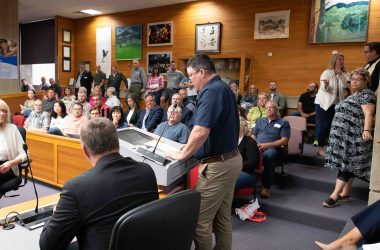It has been nearly two years since Salem police gunned down 16-year-old Bobby Brown in a shootout, leaving him dead on a city street.
Bobby was wanted for two daytime shootings in downtown Salem that spring of 2022.
When officers moved in to arrest him, he shot at them from a car. He was killed within seconds.
Bobby represents a growing number of teenagers involved in deadly street violence in the capital city.
Salem Reporter spent months trying to understand how this beloved teen who was close to graduating high school early ended up dying in a gunfight with police.
Five key revelations from the three-part series “Bobby’s Choices”:
- Bobby’s life began with challenges out of his control
Bobby was born with methamphetamine in his system and immediately went into drug withdrawal. Authorities promptly put him in foster care until he was adopted at age 4.
Babies exposed to meth often become irritable, cry uncontrollably and struggle to bond with caregivers.
Bobby’s inability to control his emotions and feelings of detachment from his adoptive parents persisted throughout his teen years.
When police moved in to arrest Bobby in July 2022, they set off flashbangs, used to disorient people. His adoptive mother, Heidi Fletemier, said that likely triggered a panicked fight-or-flight response from Bobby since he was exposed to meth before birth.
- Bobby’s family repeatedly tried to get him help that wasn’t available
Fletemier, made several efforts to get him into treatment. But Oregon lacks the kind of help that he needed.
When Bobby attempted suicide at 12 years old, he went on a waitlist for a children’s residential treatment clinic in Corvallis and never got in. The state has 304 licensed psychiatric residential beds for children across eight facilities. But none are in the Salem area and there is often a months-long wait for such care.
Fletemier also asked Marion County to provide Bobby with intensive case management, which would’ve included counseling and allowed him to help create a plan for his behavior and schooling. She said the county declined, saying he wasn’t eligible.
Reflecting after Bobby’s death, his adoptive mother said she couldn’t get the system to take her concerns seriously quick enough to get her son the help he needed.
- Bobby resisted and maneuvered around efforts to help him
As Bobby’s adoptive mom tried to find services for him, he kept running away from home.
He spent about a year and a half in treatment out of state before his counselors believed he was ready to move back with his parents. Within months, Bobby ran from home again.
He was later ordered into drug treatment but fled while being driven to the Portland facility. Two weeks after his probation officer, AJ Gosney, placed him at a treatment home in Coos Bay, he ran to a homeless encampment.
He was then sent to a youth correctional facility in October 2020, but Gosney said that Bobby was too smart for his own good as he progressed through the juvenile system. He learned from early interventions what to expect, what to do and what to say to wind down his restrictions.
Within eight months, juvenile authorities concluded that Bobby’s improved behavior, grades and engagement in treatment justified releasing him from the most restrictive custody. Two months later in February 2022, he ran away for what would be the final time.
- Bobby showed potential and was planning a fresh start before his death
Bobby demonstrated that he was interested in a healthier social life. Adult mentors always reported positive feedback, noting that he wanted to be a normal teenager who goes to high school and has a job.
Juvenile authorities described him as smart, articulate and creative. At the time of his death, the high school junior was on pace to graduate early.
Even as Bobby was embroiled in deadly gang violence, he still had one eye on getting out of Salem and starting a new, ordinary life before his dreams were cut short.
He’d gotten fed up with bad influences, who he realized were using him to do their dirty work, according to his friend. Bobby was saving money to move to Arizona with his girlfriend and start a pressure washing business.
- Gang life influenced Bobby’s actions until his final moments
Bobby craved connection with peers, which made him the perfect target to be swept up by gangs, according to Gosney.
He repeatedly ran from home to spend time at a homeless encampment in Wallace Marine Park. There, Bobby befriended a teen who was four years older and recruited him into his group, which was affiliated at the time with the Norteños gang. The last time he saw his adoptive mom, he declared, “I’m a third-generation gangbanger, mom. This is my destiny.”
A SWAT team moved in to arrest Bobby in July 2022, setting off flashbangs as he sat in a car with friends.
Others in the car believed they heard gunshots and feared that gang members were ambushing them. They later wondered if Bobby thought the same as he leaned out of the car and started shooting, drawing return police fire.
Contact reporter Ardeshir Tabrizian: [email protected] or 503-929-3053.
A MOMENT MORE, PLEASE– If you found this story useful, consider subscribing to Salem Reporter if you don’t already. Work such as this, done by local professionals, depends on community support from subscribers. Please take a moment and sign up now – easy and secure: SUBSCRIBE.

Ardeshir Tabrizian has covered criminal justice and housing for Salem Reporter since September 2021. As an Oregon native, his award-winning watchdog journalism has traversed the state. He has done reporting for The Oregonian, Eugene Weekly and Malheur Enterprise.









